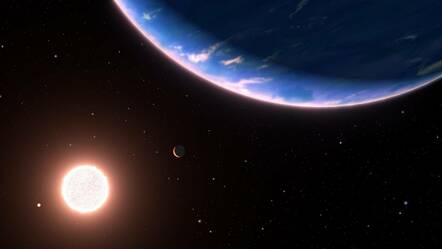Not to be outdone by the younger, hipper equipment in NASA's arsenal, the Hubble Space Telescope is still proving its worth, spotting evidence of water vapor in the smallest-ever exoplanet known to us.
"Water on a planet this small is a landmark discovery," added co-principal investigator Laura Kreidberg of the Max Planck Institute for Astronomy in Heidelberg, Germany. "It pushes closer than ever to characterizing truly Earth-like worlds."
However, GJ 9827d is only around twice the diameter of Earth, and with an orbit around its star of just 6.2 days at a distance just a fraction of Mercury's, it's really hot. If the team's observations are correct, it means the planet looks more like a steamy solar orbiter rather than an ocean pleasure world where humans could frolic.

An artist's rendering of exoplanet GJ 9827d, the large blue sphere on the right near its star and two inner worlds in the system ... For the actual observations, see the published paper [PDF]. Image credit: NASA, ESA, Leah Hustak (STScI), Ralf Crawford (STScI)
"This would be the first time that we can directly show through an atmospheric detection, that these planets with water-rich atmospheres can actually exist around other stars," said Björn Benneke of the Trottier Institute for Research on Exoplanets at the University of Montreal, Canada, and one of the scientists studying GJ 9827d. "This is an important step toward determining the prevalence and diversity of atmospheres on rocky planets."
A paper by the team detailing their discovery was published in the Astrophysical Journal Letters.
The atmosphere of GJ 9827d, which is located in the constellation Pisces about 97 light years from Earth, was observed 11 passes in front of its sun in three years. Transits are commonly used to detect the atmospheric makeup of exoplanets, as passing in front of a star allows for a good spectrographic analysis.
"Detecting water vapor in the atmosphere of such a small exoplanet shows us not only that such hydrated planets exist, but that they might be common, given that the parent star of this planet, a 'red dwarf' star, is the most common type of star in the galaxy," Dr Jennifer Wiseman, NASA's senior project scientist for the Hubble Space Telescope told The Register on Friday.
"This is an important piece of the puzzle in NASA's dedicated quest to determine what planets and environments in the universe might be able to foster and support life."
But what sort of planet is this?
While the team is confident in their discovery of water vapor in the atmosphere of GJ 9827d, they still aren't sure if they've discovered a water world hopefully without Kevin Costner) or a miniature Neptune-like gas planet with an atmosphere dominated by hydrogen and helium in which water is a minor constituent.
In the latter case, the hydrogen simply hasn't been detected. According to the Max Planck Institute for Astronomy, which participated in the research, detection may have simply failed to spot it.
"At some point, as we study smaller planets, there must be a transition where there's no more hydrogen on these small worlds, and they have atmospheres more like Venus, which is dominated by carbon dioxide," Benneke said.
The age of GJ 9827d - believed to be around six billion years – combined with its proximity to the local star suggest that its hydrogen could have been lost thanks to eons of bombardment by solar radiation.
The more interesting alternative is that the planet is more like a hot Europa, with a rocky core covered in water or water vapor, Benneke said. If that's the case, GJ 9827d likely formed further from its host star, where it turned into a ball of ice before migrating closer.
Here's where the James Webb Space Telescope and its superior powers of observation come in, said NASA Ames Research Center astrophysicist Thomas Greene.
"JWST can see much more with additional infrared observations, including carbon-bearing molecules like carbon monoxide, carbon dioxide, and methane," Greene said. "Once we get a total inventory of a planet's elements, we can compare those to the star it orbits and understand how it was formed."
We may know soon enough what sort of planet GJ 9827d is, as Benneke is the principal investigator on recent observations of the distant world using the JWST.
"We can hardly wait to see what those data reveal," said Kreidberg, who is director of the Max Planck Institute's department on atmospheric physics of exoplanets. "Hopefully, we can now settle the question of water worlds once and for all." ®
https://news.google.com/rss/articles/CBMiOmh0dHBzOi8vd3d3LnRoZXJlZ2lzdGVyLmNvbS8yMDI0LzAxLzI3L2h1YmxiZV93YXRlcl93b3JsZC_SAT5odHRwczovL3d3dy50aGVyZWdpc3Rlci5jb20vQU1QLzIwMjQvMDEvMjcvaHVibGJlX3dhdGVyX3dvcmxkLw?oc=5
2024-01-27 08:06:00Z
CBMiOmh0dHBzOi8vd3d3LnRoZXJlZ2lzdGVyLmNvbS8yMDI0LzAxLzI3L2h1YmxiZV93YXRlcl93b3JsZC_SAT5odHRwczovL3d3dy50aGVyZWdpc3Rlci5jb20vQU1QLzIwMjQvMDEvMjcvaHVibGJlX3dhdGVyX3dvcmxkLw
Bagikan Berita Ini















0 Response to "Hubble telescope spots tiniest water-rich world in orbit - The Register"
Post a Comment